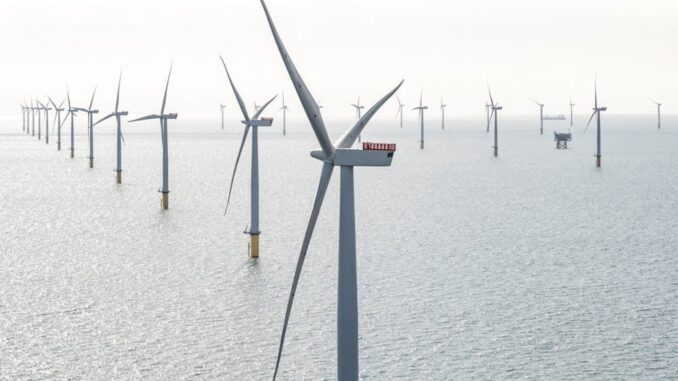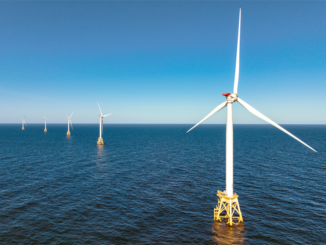
In a significant blow to the offshore wind industry, the U.S. Department of the Interior’s Bureau of Ocean Energy Management (BOEM) has issued a stop-work order for Ørsted’s Revolution Wind project off the coast of Rhode Island. The directive, announced on August 22, 2025, halts all offshore construction activities on the nearly completed wind farm, citing national security concerns amid the Trump administration’s broader pushback against renewable energy initiatives.
This move comes at a precarious time for the Danish energy giant Ørsted, which is already grappling with substantial financial losses and has recently sought a massive capital injection to stabilize its operations.
Project Overview and Current Status
Revolution Wind, a joint venture between Ørsted and Skyborn Renewables (formerly Eversource), is designed to generate 704 megawatts (MW) of clean energy—enough to power over 350,000 homes in Rhode Island and Connecticut.
Are you Paying High Taxes in New Jersey, New York, or California?
The project, located approximately 15 miles south of Rhode Island, features 65 Siemens Gamesa 11-MW turbines and was fully permitted, with construction well underway since late 2023.
As of the halt order, the project was approximately 80% complete. All offshore foundations had been installed, and 45 out of the 65 wind turbines were already in place, leaving just 20 turbines remaining to be installed.
The wind farm was on track for commercial operations in the second half of 2026, with 400 MW allocated to Rhode Island and 304 MW to Connecticut under 20-year power purchase agreements (PPAs).
The total capital cost of the project is estimated at $4 billion, reflecting the scale of investment in infrastructure, turbines, and transmission systems.
Ørsted, holding a 50% stake in the venture, has emphasized that the project complies with all federal and state permits, and the company is now evaluating legal options to challenge the order and resume work.
Potential Revenue Loss from Uninstalled Turbines
If the halt becomes prolonged or permanent, the inability to install the remaining 20 turbines could result in substantial revenue shortfalls. The missing turbines represent about 30.8% of the project’s total capacity (approximately 217 MW, based on the 704 MW overall rating). Assuming a conservative capacity factor of 45% for offshore wind (a standard industry benchmark), the full project would generate roughly 2.78 million megawatt-hours (MWh) of electricity annually. Under the PPAs, Rhode Island’s portion is priced at approximately $98.43 per MWh, while Connecticut’s pricing is comparable, averaging around $90-$98 per MWh across the agreements.
To calculate the potential annual revenue loss for the uninstalled turbines: Total annual output for full project: 704 MW × 8,760 hours/year × 45% capacity factor = 2,775,168 MWh.
Revenue at an average $98/MWh: 2,775,168 MWh × $98 = approximately $272 million per year.
Proportion for 20 turbines (20/65 ≈ 0.308): $272 million × 0.308 ≈ $84 million in annual revenue loss.
Over the 20-year PPA term, this could equate to a cumulative loss of about $1.68 billion (undiscounted), not accounting for escalation clauses or operational costs. This figure assumes the installed turbines can operate independently, which may not be the case if the halt affects the entire project’s commissioning.
Industry experts warn that delays could also inflate costs due to idled vessels, labor, and supply chain disruptions, potentially adding hundreds of millions more in expenses.
Broader Impact on Ørsted’s Financial Woes and Potential Bailout
This development exacerbates Ørsted’s ongoing financial challenges, which have been mounting due to project delays, rising interest rates, and political headwinds in the U.S. market. Just two weeks prior, on August 11, 2025, Ørsted announced a $9.4 billion rights issue to bolster its balance sheet amid a 30% plunge in its stock price.
The Danish government, Ørsted’s majority shareholder with a 50.1% stake, committed to providing roughly half of the funds—about $4.7 billion—to maintain its ownership level.
Ørsted has already reported impairments on U.S. projects, including a $575 million hit last year partly tied to Revolution Wind delays.
The halt could lead to further impairments, eroding the effectiveness of the recent capital raise and prompting calls for additional support. In a statement, Ørsted noted it is assessing the financial implications, including effects on the rights issue, and may pursue litigation to mitigate losses.
Analysts suggest this could deepen Ørsted’s projected losses for 2025-2027, potentially necessitating more government intervention from Denmark, where the company is seen as a national champion in green energy.
State officials in Rhode Island and Connecticut have vowed to fight the order, emphasizing the project’s role in meeting climate goals and creating over 1,200 jobs.
As the offshore wind sector faces increasing scrutiny under the current administration, the fate of Revolution Wind could signal broader challenges for renewable energy development in the U.S.The Energy News Beat Channel will continue to monitor this story as Ørsted and stakeholders respond to the halt.
In a significant blow to the offshore wind industry, the U.S. Department of the Interior’s Bureau of Ocean Energy Management (BOEM) has issued a stop-work order for Ørsted’s Revolution Wind project off the coast of Rhode Island. The directive, announced on August 22, 2025, halts all offshore construction activities on the nearly completed wind farm, citing national security concerns amid the Trump administration’s broader pushback against renewable energy initiatives.
This move comes at a precarious time for the Danish energy giant Ørsted, which is already grappling with substantial financial losses and has recently sought a massive capital injection to stabilize its operations.
Project Overview and Current Status
Revolution Wind, a joint venture between Ørsted and Skyborn Renewables (formerly Eversource), is designed to generate 704 megawatts (MW) of clean energy—enough to power over 350,000 homes in Rhode Island and Connecticut.
The project, located approximately 15 miles south of Rhode Island, features 65 Siemens Gamesa 11-MW turbines and was fully permitted, with construction well underway since late 2023.
As of the halt order, the project was approximately 80% complete. All offshore foundations had been installed, and 45 out of the 65 wind turbines were already in place, leaving just 20 turbines remaining to be installed.
The wind farm was on track for commercial operations in the second half of 2026, with 400 MW allocated to Rhode Island and 304 MW to Connecticut under 20-year power purchase agreements (PPAs).
The total capital cost of the project is estimated at $4 billion, reflecting the scale of investment in infrastructure, turbines, and transmission systems.
Ørsted, holding a 50% stake in the venture, has emphasized that the project complies with all federal and state permits, and the company is now evaluating legal options to challenge the order and resume work.
Potential Revenue Loss from Uninstalled Turbines
If the halt becomes prolonged or permanent, the inability to install the remaining 20 turbines could result in substantial revenue shortfalls. The missing turbines represent about 30.8% of the project’s total capacity (approximately 217 MW, based on the 704 MW overall rating). Assuming a conservative capacity factor of 45% for offshore wind (a standard industry benchmark), the full project would generate roughly 2.78 million megawatt-hours (MWh) of electricity annually. Under the PPAs, Rhode Island’s portion is priced at approximately $98.43 per MWh, while Connecticut’s pricing is comparable, averaging around $90-$98 per MWh across the agreements.
To calculate the potential annual revenue loss for the uninstalled turbines: Total annual output for full project: 704 MW × 8,760 hours/year × 45% capacity factor = 2,775,168 MWh.
Revenue at average $98/MWh: 2,775,168 MWh × $98 = approximately $272 million per year.
Proportion for 20 turbines (20/65 ≈ 0.308): $272 million × 0.308 ≈ $84 million in annual revenue loss.
Over the 20-year PPA term, this could equate to a cumulative loss of about $1.68 billion (undiscounted), not accounting for escalation clauses or operational costs. This figure assumes the installed turbines can operate independently, which may not be the case if the halt affects the entire project’s commissioning.
Industry experts warn that delays could also inflate costs due to idled vessels, labor, and supply chain disruptions, potentially adding hundreds of millions more in expenses.
Broader Impact on Ørsted’s Financial Woes and Potential Bailout
This development exacerbates Ørsted’s ongoing financial challenges, which have been mounting due to project delays, rising interest rates, and political headwinds in the U.S. market. Just two weeks prior, on August 11, 2025, Ørsted announced a $9.4 billion rights issue to bolster its balance sheet amid a 30% plunge in its stock price.
The Danish government, Ørsted’s majority shareholder with a 50.1% stake, committed to providing roughly half of the funds—about $4.7 billion—to maintain its ownership level.
Ørsted has already reported impairments on U.S. projects, including a $575 million hit last year partly tied to Revolution Wind delays.
The halt could lead to further impairments, eroding the effectiveness of the recent capital raise and prompting calls for additional support. In a statement, Ørsted noted it is assessing the financial implications, including effects on the rights issue, and may pursue litigation to mitigate losses.
Analysts suggest this could deepen Ørsted’s projected losses for 2025-2027, potentially necessitating more government intervention from Denmark, where the company is seen as a national champion in green energy.
State officials in Rhode Island and Connecticut have vowed to fight the order, emphasizing the project’s role in meeting climate goals and creating over 1,200 jobs.
The real question not talked about in the news or mainstream media is how much money has been spent on wind and solar in projects that could have been redesigned and not implemented without financial subsidies? Think about how much cheaper energy would be. The second question is how much this will save ratepayers by not completing the installation and looking for alternative natural gas or nuclear for replacement energy?
As the offshore wind sector faces increasing scrutiny under the current administration, the fate of Revolution Wind could signal broader challenges for renewable energy development in the U.S.The Energy News Beat Channel will continue to monitor this story as Ørsted and stakeholders respond to the halt.
Avoid Paying Taxes in 2025
Crude Oil, LNG, Jet Fuel price quote
ENB Top News
ENB
Energy Dashboard
ENB Podcast
ENB Substack





